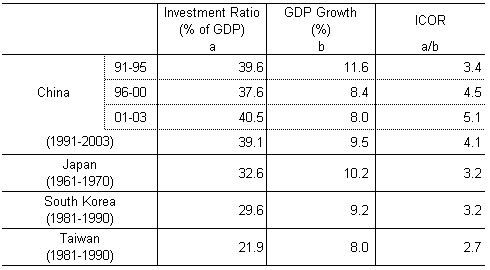Investment is the engine behind China's current economic boom. Reflecting the fact that investment is growing at a faster pace than gross domestic product, the ratio of investment to GDP is also on a rising trend. In 2003, the ratio stood at 42.7%, which was not only close to the record high China registered in 1993 (43.5%), but surpassed that of other countries. This brisk investment is supporting China's economic growth not only on the demand side, but also on the supply side through expanding production capacity. Especially, investment in the three business areas said to be overheating - steel, cement and electrolyte aluminum - grew 96.6%, 121.9% and 92.9%, respectively, in 2003. This trend continued in the first quarter of 2004, with investment in these three areas rising by 107.2%, 101.4% and 39.3%, respectively. Meanwhile, concerns are growing that the efficiency and profitability of investments will decline with this continued increase.
When considering investment efficiency in macroeconomic terms, the "incremental capital - output ratio (ICOR)" serves as a guide. ICOR is obtained by dividing the ratio of investment to GDP with real economic growth, and the smaller it is, the more efficient the investment. Because China invested 40.5% of its GDP and achieved 8% growth on average between 2001 and 2003, the capital coefficient came to 5.1 (40.5/8) (see table). In other words, in order to boost growth by one percentage point, the equivalent of 5.1% of GDP had to be newly invested. China's ICOR has been on an upward trend since the 1990s, indicating a decline in investment efficiency. Furthermore, China's average ICOR for the years 1991 to 2003 was 4.1, which was comparatively higher than that for Japan, South Korea and Taiwan when they were experiencing high economic growth. Despite the fact that Japan's growth during the 1960s was 10.2%, higher than that of present-day China, the ratio of investment to GDP was 32.6%, so that its ICOR was a low 3.2. ICORs for South Korea and Taiwan in the 1980s were 3.2 and 2.7, respectively, much lower than that for China since the 1990s.
According to China's central bank, the causes of the recent investment overheating are as follows (The Monetary Policy Report for the First Quarter of 2004). First of all, after the personnel reshuffles following the National Communist Party Congress of autumn 2002, local governments have rushed to boost investment in the quest for high growth. State-owned enterprises, meanwhile, are making excessive investments thanks to the expectation that they will receive debt forgiveness in case their business operations fail. Furthermore, local governments are offering various preferential treatment measures to private enterprises and foreign companies, artificially suppressing investment costs. These are also the direct reasons for low investment efficiency.
What is further exacerbating the situation is the fact that the financial sector is not fulfilling its role of transforming the savings of the people into effective investments due to excessive government intervention. China's capital markets are still small, and companies have no choice but to rely on banks for funding. However, just as in the case of the state-owned enterprises which are their main borrowers, the four major banks that form the core of China's banking sector still lack corporate governance and are not acting to maximize the benefits of its shareholder, the "state". In the first place, interest on loans is set at low levels to subsidize the state-owned firms that are borrowing the money, and as a result, the cost of funds does not function to guide resources to the most profitable projects. In addition, relevant parties are not obliged to take responsibility even if loans go sour.
Professor Paul Krugman of Princeton University astutely pointed out in The Myth of Asia's Miracle ( Foreign Affairs , 1994) some 10 years ago that the robust growth of the Asian economies, which came to be dubbed as the "East Asian Miracle," would be unsustainable as it was achieved not through a rise in productivity but through an increase in input. Later, we were to see that his predictions were correct as the Asian financial crisis swept through such countries as Thailand, Indonesia and South Korea. China should learn from the experiences of these Asian nations. Its engine of growth must shift from increased input to improved productivity in order to avert a crisis and sustain economic growth. To do so, it needs to use funds efficiently through reforms of its financial system and state-owned enterprises.
Comparison with Japan, Korea and Taiwan during their high-growth periods

(Souce)Based on the official statistics of each country.


